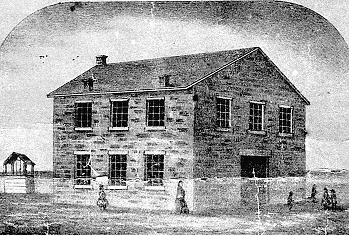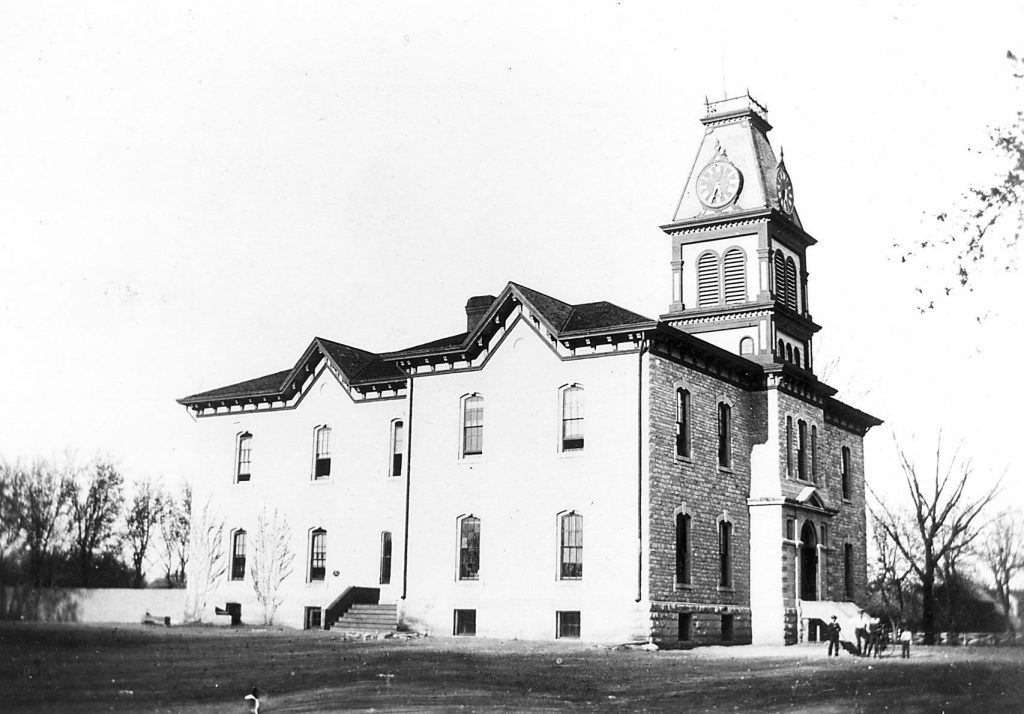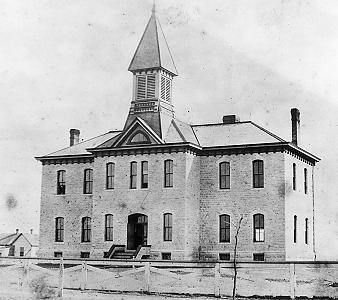By Janet (Krider) Duncan ‘58
Manhattan has had a school at 9th and Poyntz for 150 years. That’s as long as Manhattan has been incorporated as a city. Much of that time the school has included a high school, although there was apparently a time when Manhattan High School might have disappeared altogether.
The Manhattan Town Company acquired three lots on Poyntz and in 1857 the City Council built a two story building there for the new school. (Photo 1) It was said to be “the best public school building west of Topeka,” and as it was referred to in the newspaper as the “City School”, it must have been the only public school in town. There were two rooms on each floor, but initially the classroom was upstairs and a family lived downstairs until all the space was needed for the school. One teacher taught grades 1 – 8, as well as any students who continued into the next two years that were considered to be a high school education.

The new building, which became known as the “Avenue School,” cost $2,500 to build and the people of Manhattan had to hold suppers and benefits to help raise the money (taxes were to come later.) The teacher began her year with no books and no supplies. “Best” or not, the 9th & Poyntz location was not popular with all the parents. Complaints were recorded that this school was “too far away” and that the road for the children was either “too dusty” or “too muddy.”
Manhattan soon had a second source for high school education, when Blue Mont Central College opened in January of 1860. Not originally a college level institution, it began with an enrollment of 53 elementary and preparatory students. How many of these students were in the high school years is not known, but only 15 total students remained for the following fall term. (Blue Mont College charged a fee for admission – $4.00 per term for the Common Branches, $5.00 for the Higher Branches, plus extras for music. Blue Mont College was also quite a bit farther away from town than 9th and Poyntz and would add boarding facilities.)
In 1863, Blue Mont Central College reorganized under the Morrill Act to become Kansas State Agricultural College with a free education to all, other than room, board and supplies. They also continued their prep school program. So during those years, Manhattan had two places to take high school courses: the City (or Avenue) School or going up to the College Preparatory program.
Manhattan grew rapidly during those early years; there were constant references to “Immigration” in the Local News pages of the newspapers. The pressing need for a new school became obvious. In 1864, Manhattan’s City Council voted to turn their public school property over to Riley County’s newly organized County School District, “provided they levy a tax to be spent on school purposes.” The title to the land of the ‘public squares’ which were given, however, was to revert to the City if the buildings that were ultimately to be built upon them were ever to be used for anything other than a school.
When the next term (of what was then being called “our District School”) ended, the local paper, The Manhattan Independent, carried an item praising the school’s one teacher, Miss Wagner, for an excellent end of term exhibition and for her students’ “remarkably good state of discipline”: she had “more than 80 scholars embracing every stage of advancement from alphabet to algebra.” (The Board hired Miss Wagner an assistant, Miss S.P. Kimball.) At the end of that term, Miss Wagner was referred to as the Principal of the City School; a Miss E. Knopp was listed as her assistant. It was also reported, sadly, that Miss Wagner had chosen to retire from her profession.
These must have been very full years in Manhattan education. The first KSAC catalog in 1865 listed 94 students in their Prep Department, with only 14 in the College. An Omnibus system between KSAC and town was discussed.
By 1866 the last buffalo in the area had been killed, General George A. Custer was passing through Ft. Riley, as well as were the famed Buffalo Soldiers. In June of that year, the newspaper was reporting up to 90 scholars at the District School and that “the exhibition of the High School was a complete success.”
Between 1868 and 1878, the populations of both the city and the county doubled (roughly from 1000 to 2000 in the city.) By 1873, with Manhattan’s population around 1400, Riley County had formed a new Joint School District together with Pottawatomie County. The School Board voted on a bond to build a second school, but this bond was not to pass for several more years.
Between 1868 and 1878, the populations of both the city and the county doubled (roughly from 1000 to 2000 in the city.) By 1873, with Manhattan’s population around 1400, Riley County had formed a new Joint School District together with Pottawatomie County. The School Board voted on a bond to build a second school, but this bond was not to pass for several more years.
The High School classes were busy in 1873. Academic leaders were reported in the papers weekly. The Town School had a baseball team. According to the newspaper, the “first nine of the Town School Club” answered the challenge issued by the “Blue Mont Nine Baseball Club” to “any other Riley County Nine” to a “match game.” The game was played on March 13, 1873 – and the School Team won, 38 to 19! This may be the first recorded instance of a Manhattan High School sports team in competition, according to Cheryl Collins at the Riley County Historical Society.
Students at the High School also started their own paper in 1873, the ‘Manhattan High School Monitor’. Whether this was a school activity or extra curricular is not known, nor if there are copies still in existence, but this seems to be the earliest fore-runner of The Mentor.
By 1877, Manhattan was ready for another school, even a private one. A July issue of The Nationalist advised that the “Manhattan Preparatory School”, with principal James H. Lee, would begin in August. Professor Lee, formerly with Kansas State Agricultural College, was starting this new school in rooms in the 2nd story of Purcell’s Bank building (the SW corner of 3rd and Poyntz, more lately know as Burger King or Schlotsky’s.) Tuition was charged by the week, with classes ranging between 30 and 40 cents each for a wide variety of subjects.
Then in 1878, the School District’s bond issue, for $10,000, passed and the Central School was built in the 600 block of Leavenworth (where Woodrow Wilson Elementary School is now.) A stone building facing south (Photo 2) it provided for Manhattan’s first dedicated public high school, with two years for the English curriculum and three years for the Classical curriculum (with Latin, Greek and philosophy as basic courses.) During it’s lifetime, it also housed four primary grades (1-4) and four grammar years (grades 5-8) and east and west wings were added in 1909. Manhattan’s public High School must have moved over to Central School at this time, leaving the Avenue School at 9th and Poyntz to the lower grades.

The preparatory school at KSAC, now 20 years old, was still available (provided their entrance requirements were met) and the estimate for the funds necessary for room, board and incidental supplies, for four years of education in 1877, was $50.00. Professor Lee, of the private Manhattan Preparatory School, became the Riley County Superintendent of Schools in 1880, so it is likely that his school was short- lived.
Manhattan became a City of the Second Class in 1880, and the citizens elected their first Board of Education. The early 80s also saw the Riley County Bank fail. A Small Pox scare in the area caused the Board of Education to vote to “exclude all unvaccinated children from school.”

And the Avenue School, the “best public school building west of Topeka,” was no longer adequate. By February 1882, the School Board had made the decision to raze it. They got another $10,000 bond passed, which included $2,000 for adding steam heat to the Central School and built the second school to occupy the land at 9th and Poyntz (photo 3). Also known as the Avenue School, it opened when the term began on October 2, 1882, with only two rooms of its four rooms ready (students sat two to a desk.) It may have become the Grammar School (grades 5-8) but more research here is needed. (Please stay tuned.)
The student estimate for Manhattan High School for the fall term of 1883 was 40-45 students, not counting non-residents. In December of 1883, KSAC reported 324 students, with 110 women, but how many were prep school students is not available.
Moving ahead, 1892 marks the year of the first Manhattan High School Graduation ceremony, according to a History of Manhattan written for the 1927 Blue M. That was still graduation from a two year high school course, this tells us, as it was “impossible to maintain a four year course prior to 1915 because of the low requirements of the College.” The story on the front page of the May 27, 1892 paper carried this headline: “Diplomas conferred, a credit to all concerned.” But apparently this Commencement almost didn’t happen. The first sentence of their story read: “One year ago the Board talked very seriously of doing away with the High School.”
What happened? More research is needed. Our history leaves Manhattan High School cutting its teeth at 9th and Poyntz, then moving over to 6th and Leavenworth in 1878 to develop. Watch the next issue of The Alumni Mentor to get us back to 9th and Poyntz. There are still surprises.